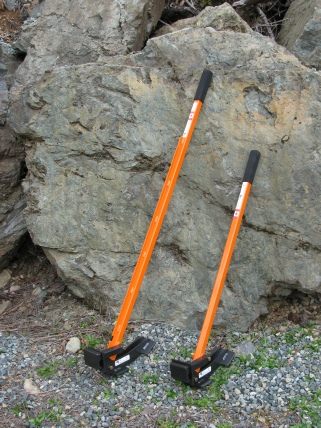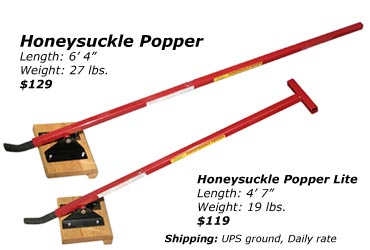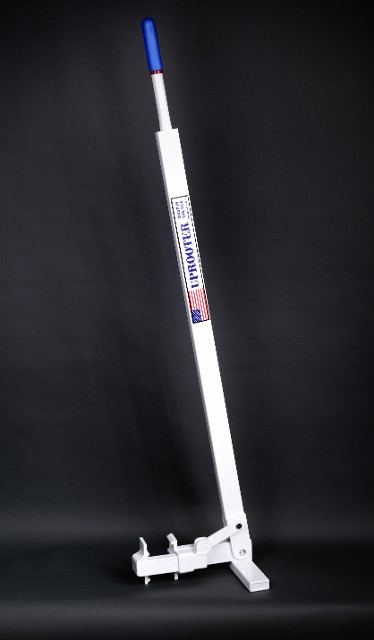
Northwest Illinois Forestry Association:
Sustainable Woodland Stewardship in Northwest Illinois
- Home
- Invasive Species
- Tools for Invasive Species
Tools for Invasive Species Work
Chris Evans, IDNR Invasive Species Campaign Coordinator, reports "I get questions on the availability and use of different tools for removing woody shrubs and thought I’d send out this excellent summary by Jane Morse of tools they are using in the Terre Haute area. I also added a few other tools after her summary."
Chris' summary appeared so helpful, that we thought we'd share it with all of you below. NIFA is not endorsing any of these products. We are merely informing our visitors that these tools are available.
<<<<<<<>>>>>>>
1. The Extractigator is light and easy for women and children to use. It is very effective; it is like a clamp on a stick. When you hold the device upright the clamp is opened. You then kick it into place around the base of the plant and then as you rock back the clamp closes and the bush comes out with power leveraged by the stick. It works VERY well when it works. The problem is that whenever there are a lot of spindly stems coming out of the ground in a cluster, or several thick stems that go sideways from ground level, etc, etc, you have to do some pruning and often also have someone kneel down to push the clamp into place before you can pull. This slows things down for the bigger bushes. But it is very fast and efficient with the smaller ones. I would only buy the larger size and don’t buy this tool without getting the “Big Foot” attachment. It really helps to leverage your muscles. As of November 2014, the Extractigator was priced at $155 (for the larger size) plus shipping. Available at http://extractigator.com
2. The Honey Suckle Popper is more like a huge crochet hook on a heavy wooden fulcrum. This tool is, I  think, 4 - 6 pounds heavier. Guys like it. Sometimes I think they like it just because it is heavier, but it also works on more plants without the problems of bush habit at the ground lever, which is a factor with the extractigator. You stab the business end of this long crotchet hook into the ground and hopefully get it under the root ball. If the ground is hard, that can be a problem. You can also have trouble with the roots interfering with your ability to get close enough to the root ball. But if you can get the hook in the right place then you lean back on the stick and the big wooden block, which acts as your fulcrum, hits the ground and as you push on the long stick you pop the base of the plant out of the ground and snap the roots. The problem with this tool is that if the roots don’t snap easily, people automatically start jumping on the stick or using the weight and strength of several people to get the bush out. If you do this it doesn’t take long to break the tool. However, you can use the Popper to stab under that root and break it so you don’t have to reach for another tool. The Honey Suckle Popper can be purchased at http://www.misterhoneysuckle.com, both models selling for $159 each.
think, 4 - 6 pounds heavier. Guys like it. Sometimes I think they like it just because it is heavier, but it also works on more plants without the problems of bush habit at the ground lever, which is a factor with the extractigator. You stab the business end of this long crotchet hook into the ground and hopefully get it under the root ball. If the ground is hard, that can be a problem. You can also have trouble with the roots interfering with your ability to get close enough to the root ball. But if you can get the hook in the right place then you lean back on the stick and the big wooden block, which acts as your fulcrum, hits the ground and as you push on the long stick you pop the base of the plant out of the ground and snap the roots. The problem with this tool is that if the roots don’t snap easily, people automatically start jumping on the stick or using the weight and strength of several people to get the bush out. If you do this it doesn’t take long to break the tool. However, you can use the Popper to stab under that root and break it so you don’t have to reach for another tool. The Honey Suckle Popper can be purchased at http://www.misterhoneysuckle.com, both models selling for $159 each.

3. The Root Buster is like a pile driver only with a wedge shaped blade at the business end. Whenever you have trouble getting a bush out of the ground, you can usually feel where the resistance is and then you put the Root Buster over the area and start stabbing into the ground until you find the root. You can even stab in a full circle and then pull the bush out without any other tools but I don’t like doing that. The problem with this tool is that the pin is a pain to put in and take out so you tend to take it out when you enter the woods and put it back in when done. (Assuming you haven’t lost the pin…) This means that the forked blade can easily fall out of the handle and cut off someone’s toes - not good. If the pin is out you have to be meticulous about carrying it only when the blade is up and the handle is down. I always demonstrate this to kids and make them count their toes before they enter the woods and so far everyone has come back with 10 each. Tractor Supply calls it a Brush Grubber™ Heavy Duty Root Buster ($39.99 as of 11/2014) and they sell it a bit cheaper than others. You can find it online from many dealers.
4. I don’t use this tool because I work with students but you would probably like the Saws All for removing roots. It is rough on the tool but it does work. Stab the saw blade in the ground and saw through the dirt until you cut the root. This is really fast and efficient but I can’t give power tools to kids. The advantage to you is that it is also lighter to carry into the woods, just carry a spare battery and always be certain it is fully charged before you begin a work day. At Amazon, you can find these starting at $20 all the way up to over $1,000 depending on brand and features.

5. The Uprooter (shown on the right) – Many of you are familiar with the Weed Wrench, which is no longer being produced. An employee of that company has started his own business and is now selling a similar tool as ‘The Uprooter’. It is lighter in weight and has a larger clamp size. It is available here for $150 plus $30 shipping (as of November 2014) http://www.theuprooter.com/
 6. The Pullerbear (shown on the left) – This is similar to the Weed Wrench, and is made in Canada. Their website gives a comparison of this tool to the Extractigator and the Weed Wrench. There are three models for $87, $100, and $150 plus $35 shipping (as of November 2014) at http://www.pullerbear.com/compare.html
6. The Pullerbear (shown on the left) – This is similar to the Weed Wrench, and is made in Canada. Their website gives a comparison of this tool to the Extractigator and the Weed Wrench. There are three models for $87, $100, and $150 plus $35 shipping (as of November 2014) at http://www.pullerbear.com/compare.html